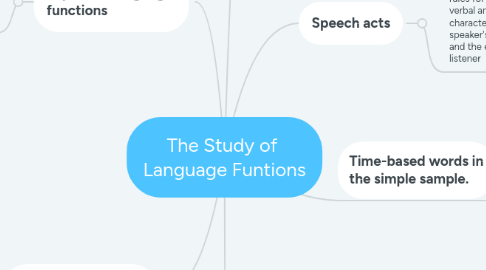
1. Expanded language functions
1.1. Through these: a speaker can talk about ideas that cannot be seen
1.1.1. Redundacy here: concepts increase in meaning to them point where they must become a new concept.
1.1.2. Productivity here: Concepts mean similar ideas whether they are in spoken jor written form.
1.1.3. Flexibility here: Concepts can be used in a variety of ways and the communication with other takes on more variety.
1.1.4. Semanticy here: Concepts increase in conmplexity from the overtapping and layering of meaning.
1.1.5. Displacement is: An expanded language function that begins early on and continues to expland throughout a person's thinking.
2. The study of language structures
2.1. English rules of structure
2.1.1. Underlying meaning of language structures. Summary of language structures.
3. Time-based words in the simple sample.
3.1. • English sounds (phonology) form into consonant-vowel-consonant (C-V-C) combinations. • English words (semantics) in isolation convey meaning. • English time concepts are plentiful. • English has a written alphabetic sound-letter structure. • English uses a subject-verb-object (S-V-O) syntax. • English has specific types of morphemes (morphology). • English is a low-context language.
4. Recognizing English structures.
4.1. Parts of English language include pronouns, conjunctions, articles, and prepositions. These structures also have a meaningful function.
4.1.1. The word “my” refers to something owned by someone or to whom something belongs.
4.1.2. Both “at” and “for” prepare the listener for what happens to the object of the sentence and are therefore called prepositions.
4.1.3. Therefore “my” is a possessive pronoun. “Possessive” refers to ownership and a pronoun refers to replacing the person with a word that refers to the person.
4.1.4. The words “the” and “a” function to determine whether the noun is specific.
4.1.5. There are small words that conjoin or connect ideas such as the word “and.” The word “and” is a conjunction because it conjoins two or more ideas
5. Speech acts
5.1. These: include the rules for the context, verbal an non-verbal characteristics of the speaker's utterance, and the effects on the listener
5.1.1. For speech acts to be effective: they must affect the way the listener assigns meaning
5.1.1.1. This means that: the speaker must understand thtat the listener (heaver) must be able to assign the meaning the speaker wants
